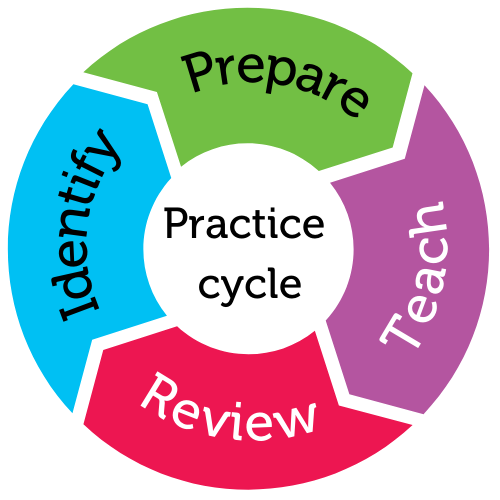
For student year
Helps students to
- be more engaged
- focus across topics
Helps teachers to
- engage students
- connect with students
Summary
For the secondary school version of this practice, go to:
Harnessing students interests (Years 7 to 12)
Some students, including those on the autism spectrum, may have certain focused interests and knowledge, i.e. one or two specific areas they are intensely interested in. Students may be stronger in these areas than in other areas of their development, and they may have more knowledge than their peers in these areas.
Research suggests that harnessing these interests by including them in curriculum materials and classroom instruction can:
- motivate students to complete tasks
- make learning more meaningful and
- help students to engage.
How the practice works
Watch this video to learn more about how to harness student interests in the classroom.
Duration: 4:13
Australian Professional Standards for Teachers related to this practice
1.5 - differentiate teaching to meet the specific learning needs of students across the full range of abilities
1.6 - strategies to support the full participation of students with disability
4.1 - support student participation
For further information, see Australian Professional Standards for Teachers AITSL page
Preparing to teach
How to use student interests in the classroom
Know your student well – communicate with your student and liaise with parents to identify the student’s focused interests.
After you have identified these areas of focused interest, you can:
- embed the student’s interests into curriculum tasks as a whole-class plan
- provide individualised tasks for the student
- use the interests to motivate the student using the Premack principle.
The Premack Principle is a positive reinforcement strategy where a preferred activity is offered as a reward for the completion of a less preferred task.
Embedding special interests into the curriculum
When planning a lesson, consider which of the student’s interests might be appropriately embedded.
Example
A teacher is attempting to engage a student in a unit of work about modern Japanese culture. As this particular student has a focused interest in trains, the teacher does a lesson on the rail systems in Japan.
Adapting individualised tasks
Using a student’s area of interest does not have to be time-consuming. You can adapt the task to offer choice for the individual student to link it with their area of interest.
Example
In an assignment about Ancient Rome, students are to write a script of an interview between themselves and Julius Caesar. The teacher suggests to the student with a focused interest in Spiderman that they write a script with Spiderman interviewing Julius Caesar.
This example could also work as a whole-class approach – each student could choose their favourite character to be the interviewer.
Motivating students
Use a student’s area of interest to motivate them to complete less-preferred tasks by using the Premack principle. This is where the student must complete a less-preferred task to a satisfactory standard to be allowed access to their focused interest.
Make sure you:
- show the order of tasks
- clearly describe what the ‘satisfactory standard’ looks like.
Example
- Read all of page 54.
- Write a five-sentence paragraph to summarise page 54.
- Read The Lord of the Rings for 15 minutes (the student’s preferred activity).
It works better if the teacher:
- sets a realistic amount of work for the student to complete to access their area of interest
- allows enough time for the student to engage with their interest after completing the less-preferred task
- regularly assesses and reviews whether the use of an area of interest is helpful and what further adjustments may be needed next time.
It doesn’t work if:
- a focused interest is used to punish the student, e.g. taking away access to the focused interest
- the teacher changes expectations partway through using the Premack principle – this is likely to increase anxiety and decrease trust.
In the classroom
- Deliver the lesson to students
- ensure individualised tasks are adequately explained
- provide explicit instruction and expectations.
- If the task is completed successfully, praise the student.
- Monitor student progress and levels of engagement in the content or activity.
- If the student needs further motivation, create a visual chart or checklist for the student to monitor their own learning and show when they can engage with their focused interest throughout the day.
Practice toolkit
Practice implementation planner template
We know it's not always easy to keep track of what's working and what isn't. So, we've created this template for you to record and reflect on what you're doing to create more inclusive classrooms. The implementation planner contains:
- guidance around goal setting
- a reflection section (what worked, didn’t work, what to change, and next steps)
- prompting questions.
Implementation planner with examples
Set your professional learning goal for:
Harnessing student interests
Benefits of goal setting
Setting, working towards, and reflecting on goals helps you grow professionally and improve your practice. You can access AITSL learning resources for teachers to learn more about:How to set goals
The Australian Institute for Teaching and School Leadership recommends using the SMART matrix to frame your goal setting.SMART goals refers to goals that are:
- Specific
- Measurable
- Achievable
- Relevant
- Time-phased
Resources
Harnessing student interests - Practice Brief
Related Practices

Embedding opportunities for choice making
TEACHING PRACTICE
For student years
Helps students to
- make decisions
- build independence

Harnessing student interests (Secondary)
TEACHING PRACTICE
For student years
Helps students to
- be more engaged
- focus across topics
This practice is from the core research project
Learning Cycle

Set your practice implementation goal
Evidence
This practice was developed as part of the Models of practice project. More information about the evidence informing this practice is available on the project page.
